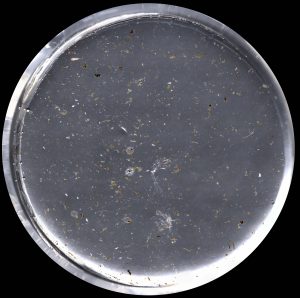 Last year I sailed on the Sea to Space Particle Investigation research cruise aboard the R/V Falkor.
Last year I sailed on the Sea to Space Particle Investigation research cruise aboard the R/V Falkor.  Our goal on that cruise was to connect surface phytoplankton communities with the amount of carbon exported out of the surface ocean and to identify the ecological mechanisms leading to their export. The most direct pathway between plankton and carbon export is direct settling of cells. On this cruise we deployed sediment traps containing polyacrylamide gel layers, like this one on the left. If you look closely, you will see individual particles (fecal pellets and aggregates) that sank into the gel. You can also see the remains of zooplankton that swam into the gel. When I examine the gel at higher magnification, I can see individual phytoplankton and protists (collage at the right). Because the gel isolates the particles as they fall into it, we can be relatively confident that these cells sank as individuals and not within larger detrital particles. Individual cells make up a small but consistent component of the total carbon export. On this cruise, they accounted for ~3-5% of total carbon flux at 150 m deep. The cells in the collage include dinoflagellates, coccolithophores, diatoms, foraminifera, radiolarians, and cilliates. The large spherical cell at the bottom is a phaeodarian, relative of the radiolarians, and is ~1 mm in size. Some of these protists are large enough to see in the gel image at low magnification.
Our goal on that cruise was to connect surface phytoplankton communities with the amount of carbon exported out of the surface ocean and to identify the ecological mechanisms leading to their export. The most direct pathway between plankton and carbon export is direct settling of cells. On this cruise we deployed sediment traps containing polyacrylamide gel layers, like this one on the left. If you look closely, you will see individual particles (fecal pellets and aggregates) that sank into the gel. You can also see the remains of zooplankton that swam into the gel. When I examine the gel at higher magnification, I can see individual phytoplankton and protists (collage at the right). Because the gel isolates the particles as they fall into it, we can be relatively confident that these cells sank as individuals and not within larger detrital particles. Individual cells make up a small but consistent component of the total carbon export. On this cruise, they accounted for ~3-5% of total carbon flux at 150 m deep. The cells in the collage include dinoflagellates, coccolithophores, diatoms, foraminifera, radiolarians, and cilliates. The large spherical cell at the bottom is a phaeodarian, relative of the radiolarians, and is ~1 mm in size. Some of these protists are large enough to see in the gel image at low magnification.
Although most carbon is exported by detrital aggregations and fecal pellets, these individually sinking cells are fascinating. And beautiful.

